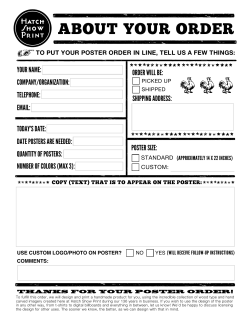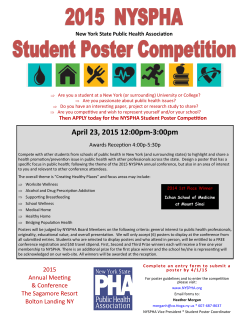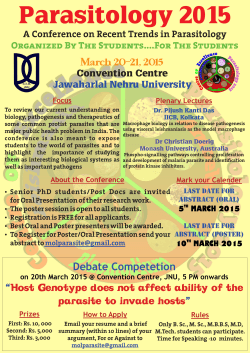
2015 ECHO Asia Agriculture and Community Development
2015 ECHO Asia Agriculture and Community Development Conference Poster Session Announcement We are pleased to announce that the 2015 ECHO Asia Agriculture and Community Development Conference will feature a poster session. This will provide conference attendees with another way, in addition to a talk or workshop, to share and exchange information. If you plan to attend the conference (see www.ECHOcommunity for dates, registration and cost information), please consider creating a poster for display at the hotel. Your poster can then be viewed by other conference delegates at their leisure, as well as during designated times for poster presenters and other conference attendees to interact. There will also be an opportunity, during an evening session, to give a five-minute oral summary of your poster. Below are some specifics on how to participate in our first conference poster session. Poster categories Posters should relate to small-scale agriculture or community development. Practices and techniques presented should be those that are affordable and that can be implemented with local resources. We are looking for posters that fall within the following categories: Research summaries These posters relay information on findings learned from varying levels of experimentation. This is a good fit for scientists, graduate students, or student researchers. It is also a good fit for development practitioners to present knowledge gained from farmer field trials, observation trials conducted on project sites, or results of various surveys. Development project summaries This type of poster is less research-oriented, presenting lessons learned from the implementation of agriculture-related development projects. For example, a poster could shed light on the effectiveness of a particular development approach, crop production practice, or appropriate technology. Crop evaluations This is a distinct category focused on crops. Featured crops could include cereal grains, multipurpose trees, fruits, vegetables, forages, legumes, Neglected and Underutilized Species (NUS) or any other category of plants found to improve the lives of farmers and gardeners. Whether the information is gleaned from a research or development project, this is a good way to share insights on how well a crop has performed or been adapted by farmers in your part of Asia. Presenter responsibilities Please email a title and brief summary (abstract) of your poster to echoasia@echonet.org with “Conference Poster” written in the subject line. Abstracts can simply be 2-3 sentences and should be no longer than 300 words. Depending on available space and appropriateness of the topic, a member of ECHO’s staff will then respond regarding acceptance of your poster and provide any further input. Providing this information in a timely manner will allow us to promote the poster session in our conference program booklet. Additionally, in your email, please indicate whether or not you are okay with your title/abstract being posted on www.ECHOcommunity.org after the conference. We also ask that each presenter be responsible for developing, printing, and bringing their own poster to the conference. This includes any expenses incurred. Below are some general guidelines and resources for developing a poster. Printed poster preparation guidelines Use of PowerPoint Most commonly, posters to be printed are prepared on a single PowerPoint slide. It is important to know beforehand where you can have your poster printed. Students and scientists often have access to printers at their college or university. Alternatively, many print shops can provide printing services for posters. Paper sizes that can be run through a printer will determine which page setup options you select in PowerPoint. To be able to accommodate everyone’s poster, we would prefer that not exceed 120 cm (48 inches) in width or height. There are numerous publications online that give instructions on how to prepare a poster in PowerPoint. One such document, entitled Create a Poster in PowerPoint 2010, is found at http://www.emich.edu/apc/guides/apcposterpowerpoint2010.pdf. Design considerations Presenters are free to be creative as far as background and color choices. The main consideration to keep in mind is readability. Keep the following in mind: o A text color that contrasts well with the background color will help the words stand out. Black text on a white background, for instance, works well. o Present information clearly and simply. People will be less likely to read your poster if it has too many words. Consider using colored graphs or photos in place of long numerical tables. o Keep the layout from being too crowded. Leave a 2.5 cm (1 in.) border around the edges and ample spaces around text boxes. Keep body text left-aligned or fully justified; do not right-justify the text. Use conventional fonts such as Arial, Helvetica or Tahoma, and only use one or two fonts. For a display poster developed from a single PowerPoint slide, suggested font sizes are 72-120 points for the title and 24-48 points for body text. Headings of more than six words should be in upper and lower case instead of all capitals. Never write whole sentences in all capitals or underline; use bold characters to stress your point. Bullets are a great way to make a simple and clear point. Do not attempt to put too much information on your poster! The poster should give enough information to the viewer to explain the gist and then allow the viewer to gather more information from the presenter. Spell check and proof-read before printing a final version. A document entitled Poster-making 101 contains much more advice on design considerations and is found at http://abacus.bates.edu/~bpfohl/posters/. A sample poster can be viewed at [give ECHOcommunity URL]. Poster elements Each poster should have the following blocks of information: Title and authors: This information is shown at the top of the poster. Any organizational logos are often shown here as well. Background and Introduction: This section presents the “why” of your research or project. Provide a sense of context, including the location in which your work was done. Explain a problem (e.g., crop production constraints in a given area) or set of issues that your research or development project addresses. Purpose or Objectives: Present a short list of primary objectives, or a single over-arching goal of the work presented. Methodology: This section presents the “how” of your work. It is impossible in a poster to go into too many specifics. In broad terms, though, describe materials used, how the study or project was implemented, and how information and data were gathered and processed. Results: Here is where important findings are presented. In addition to brief statements, this section can also contain supporting tables, graphs and/or photos. Conclusions or Outcomes: Based on the findings presented in the Results section, outline conclusions or outcomes. This could involve listing key take-a-ways that you want people to remember and/or implications of your work to smallholder farmers. It is okay to have a combined Results and Conclusions or Results and Outcomes section. Oral Poster Preparation Guidelines This applies to those displaying a printed poster who would also like to give a five-minute PowerPoint presentation of their poster during an evening session. You may use a maximum of seven slides for this. Start with a title and author slide. Remaining slides could consist of an introduction and objectives slide, a slide on methodology, one or two results and conclusions slides, and a final acknowledgment slide. As with the printed poster, keep everything simple and short. Five minutes is enough time to present key points, but not enough to go deeply into long tables or complex graphs. A more detailed guide for an oral, poster can be found at [URL on ECHOcommunity].
© Copyright 2025









